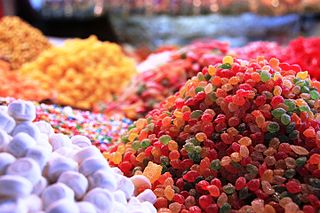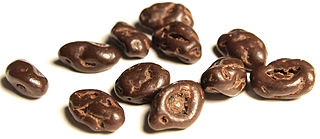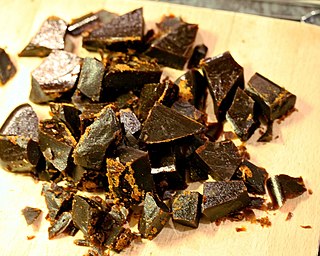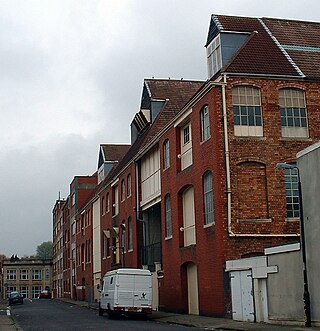
Confectionery is the art of making confections, which are food items that are rich in sugar and carbohydrates. Exact definitions are difficult. In general, however, confectionery is divided into two broad and somewhat overlapping categories: bakers' confections and sugar confections. The occupation of confectioner encompasses the categories of cooking performed by both the French patissier and the confiseur.

A convenience store, bodega, convenience shop, corner store or corner shop is a small retail store that stocks a range of everyday items such as coffee, groceries, fruits, vegetables, snacks, confectionery, soft drinks, ice creams, tobacco products, lottery tickets, over-the-counter drugs, toiletries, newspapers and magazines. In some jurisdictions, convenience stores are licensed to sell alcoholic drinks, although many jurisdictions limit such beverages to those with relatively low alcohol content, like beer and wine. The stores may also offer money order and wire transfer services, along with the use of a fax machine or photocopier for a small per-copy cost. Some also sell tickets or recharge smart cards, e.g. OPUS cards in Montreal or include a small deli. They differ from general stores and village shops in that they are not in a rural location and are used as a convenient supplement to larger stores.

In Australia, a milk bar is a suburban local general store which can include delicatessens or "delis" and corner shops or corner stores. Similar, but not identical, establishments include tuck shops. Milk bars are traditionally a place where people buy newspapers, and fast-food items such as fish and chips, hamburgers, milkshakes, and snacks. They are essentially a smaller-scale suburban form of the convenience store but are more likely to be "mum and dad" small businesses rather than larger franchised operations.

Candy, also called sweets (BrE) or lollies, is a confection that features sugar as a principal ingredient. The category, called sugar confectionery, encompasses any sweet confection, including chocolate, chewing gum, and sugar candy. Vegetables, fruit, or nuts which have been glazed and coated with sugar are said to be candied.

A grocery store (AE), grocery shop (BE) or simply grocery is a foodservice retail store that primarily retails a general range of food products, which may be fresh or packaged. In everyday U.S. usage, however, "grocery store" is a synonym for supermarket, and is not used to refer to other types of stores that sell groceries. In the UK, shops that sell food are distinguished as grocers or grocery shops.

Liquorice allsorts are assorted liquorice confectionery sold as a mixture. Made of liquorice, sugar, coconut, aniseed jelly, fruit flavourings, and gelatine, they were first produced in Sheffield, England, by Geo. Bassett & Co Ltd.

A school meal is a meal provided to students and sometimes teachers at a school, typically in the middle or beginning of the school day. Countries around the world offer various kinds of school meal programs, and altogether, these are among the world's largest social safety nets. An estimated 380 million school children around the world receive meals at their respective schools. The extent of school feeding coverage varies from country to country, and as of 2020, the aggregate coverage rate worldwide is estimated to be 27%.

Chocolate-covered raisins are a candy consisting of individual raisins coated in a shell of milk, dark or white chocolate.

Bonfire toffee is a hard, brittle toffee associated with Halloween and Guy Fawkes Night in the United Kingdom. The toffee tastes very strongly of black treacle (molasses), and cheap versions can be quite bitter. In Scotland, the treat is known as claggum, with less sweet versions known as clack. In Wales, it is known as loshin du. The flavour is similar to that of butterscotch, although it is a toffee and never a viscous liquid.

A Konditorei is a business that typically offers a wide variety of pastries and typically also serves as a café. Konditoreien (plural) are found in many different countries including but not limited to Germany, Austria, Switzerland, France, Denmark, Sweden, and the Czech Republic. In French-speaking countries, similar businesses are referred to as pâtisseries.

George Bassett & Co., known simply as Bassett's, was a British confectionery company and brand. The company was founded in Sheffield by George Bassett in 1842. The company became a brand of Cadbury Schweppes in 1989. The brand's final owner was Mondelēz International, which merged the brand with Maynards to create Maynards Bassetts in 2016.

A confectionery store are stores that sell confectionery and the intended market is usually children. Most confectionery stores are filled with an assortment of sweets far larger than a grocer or convenience store could accommodate. They frequently provide a variety of international sweets and retro delicacies. Very often unchanged in layout since their inception, confectioneries are known for their warming and nostalgic feel.

A pâtisserie is a type of Italian, French or Belgian bakery that specializes in pastries and sweets, as well as a term for such food items. In some countries, it is a legally controlled title that may only be used by bakeries that employ a licensed maître pâtissier in French, meester banketbakker in Dutch, Konditormeister in German. In Dutch often the word banketbakkerij is used for the shop itself and banketgebak for the confections sold in such an establishment.

Elizabeth Shaw Ltd is a Bristol-based company owned by Colian Holding that markets chocolate-based confectionery, including the brands Famous Names Chocolate liqueurs and Elizabeth Shaw Mint chocolates. The modern company was formed from several mergers of well established confectionery companies, first by J A & P Holland and then by James Goldsmith in the 1960s as part of his creation of his food conglomerate Cavenham Foods.
Maynards was a British confectionery manufacturer best known for manufacturing wine gums. It was acquired by Cadbury in the 1990s, which in turn was acquired by Mondelez International in 2010. In 2016, the brand was joined with Bassett's to create Maynards Bassetts.
Atique Islam Choudhury is an English restaurateur and chef.

Shane Confectionery is an American candy shop and candy producer, located at 110 Market Street in Philadelphia, Pennsylvania. Currently owned by Ryan and Eric Berley, it is considered the longest-running confectionery business in the United States. The original confectionery business at the location opened in 1863. They are known for making traditional specialties including previous owner Edward Shane's buttercream chocolates and Pennsylvania clear toy candy.

This is a categorically-organized list of foods. Food is any substance consumed to provide nutritional support for the body. It is produced either by plants, animals, or fungi, and contains essential nutrients, such as carbohydrates, fats, proteins, vitamins, or minerals. The substance is ingested by an organism and assimilated by the organism's cells in an effort to produce energy, maintain life, or stimulate growth.
The Confectionery Workers' Union of Australia (CWUA) was an Australian trade union which existed between 1925 and 1992. Until 1986, it was known as the Federated Confectioners' Association of Australia (FCA). Throughout its existence, it represented factory workers in the confectionery industry, including a high proportion of women. It was also notable for its involvement in the landmark Dollar Sweets Dispute.
The retail format influences the consumer's store choice and addresses the consumer's expectations. At its most basic level, a retail format is a simple marketplace, that is; a location where goods and services are exchanged. In some parts of the world, the retail sector is still dominated by small family-run stores, but large retail chains are increasingly dominating the sector, because they can exert considerable buying power and pass on the savings in the form of lower prices. Many of these large retail chains also produce their own private labels which compete alongside manufacturer brands. Considerable consolidation of retail stores has changed the retail landscape, transferring power away from wholesalers and into the hands of the large retail chains.

















